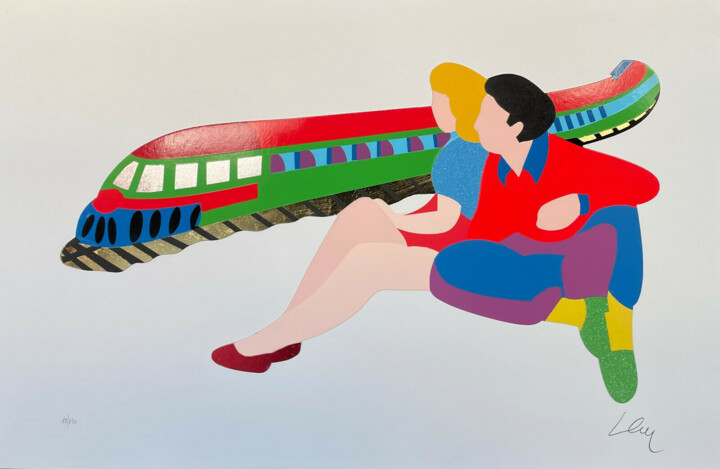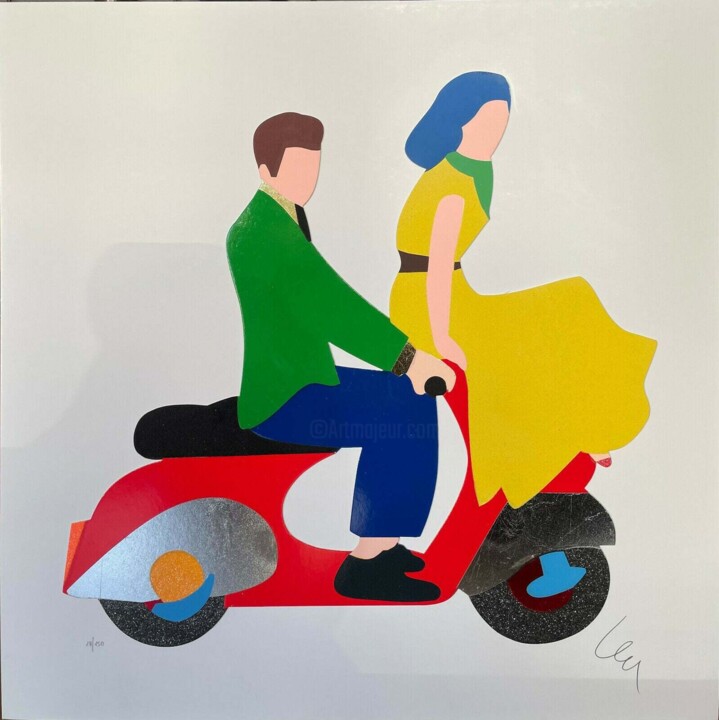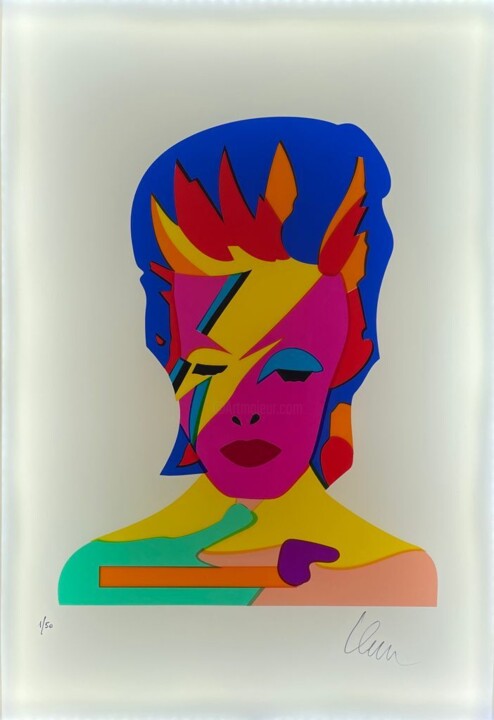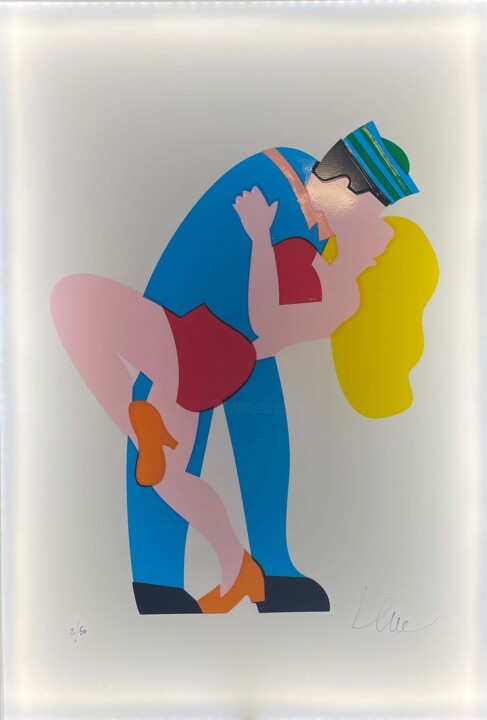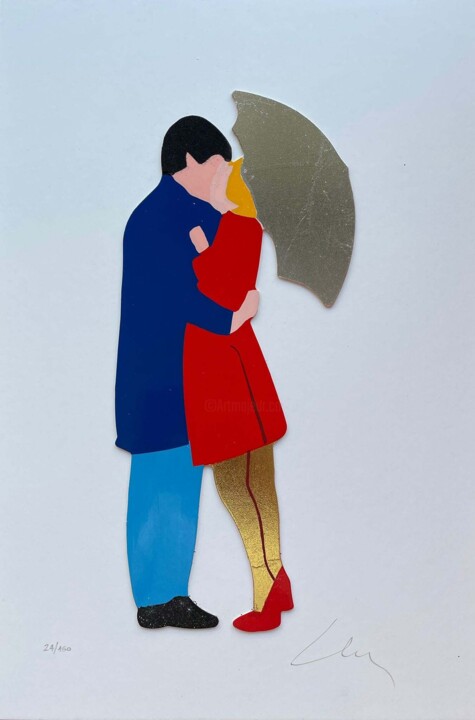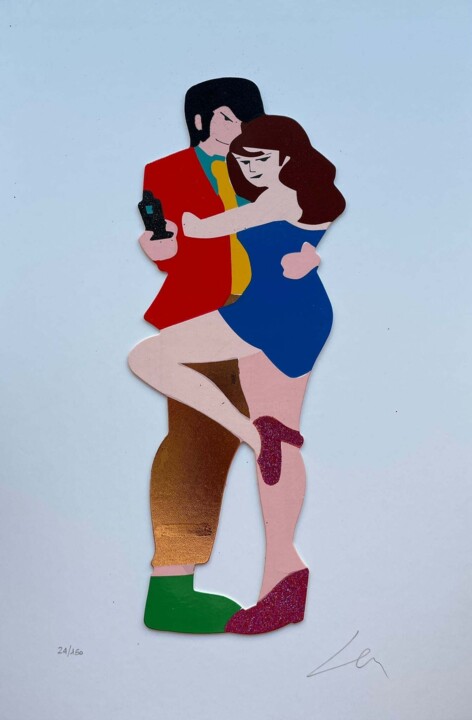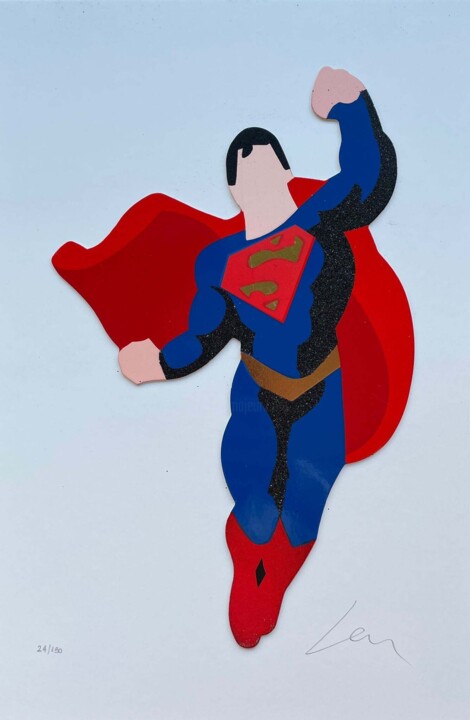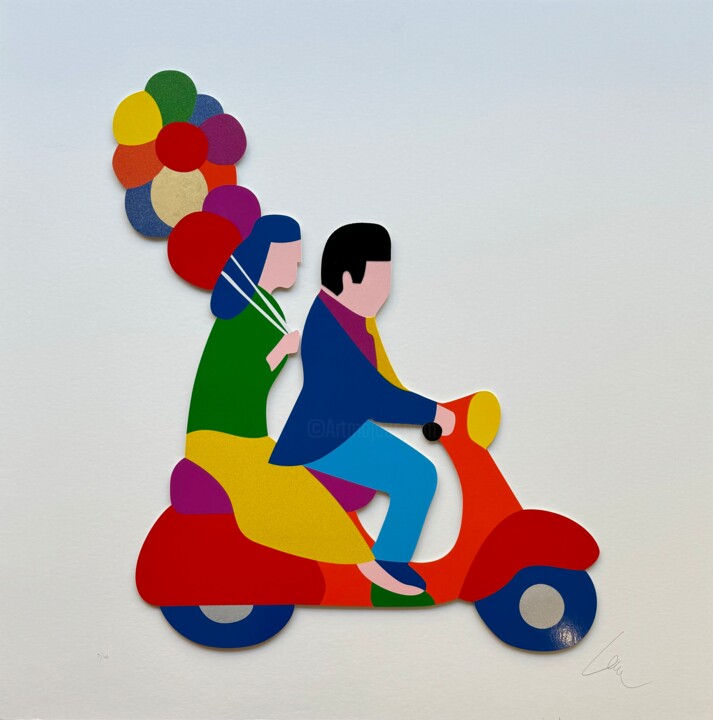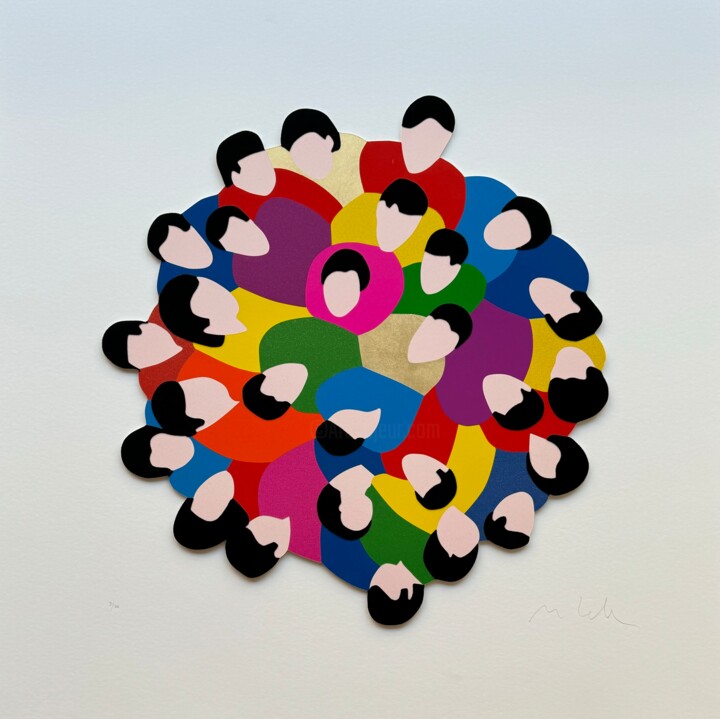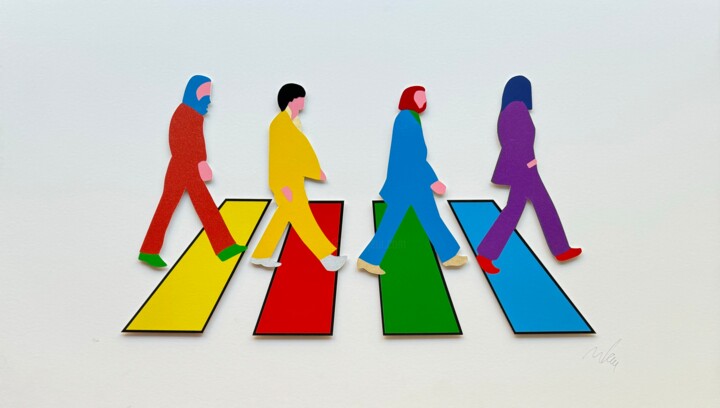Marco Lodola is an Italian maestro celebrated for his talent in conveying emotions through his pioneering use of illumination and color. His pieces are a burst of vitality, merging components of pop art with a contemporary approach to both sculpture and painting.
Illuminating the Art World with Light and Color
Marco Lodola, an influential figure in modern art, was born on April 4, 1955, in Dorno, a quaint town in the province of Pavia, Italy. His early years in this peaceful Italian environment laid the foundation for his vibrant creative journey. Pursuing his passion for creativity, he studied at the esteemed Academy of Fine Arts in Florence, followed by the Academy of Fine Arts in Milan. These renowned institutions have fostered some of Italy’s most notable talents, and it was here that Lodola honed his skills and developed his unique aesthetic.
His artistic trajectory began to take form in the 1980s, a decade marked by a resurgence of innovative and dynamic art movements. His initial creations quickly attracted attention, setting him apart as a unique voice in the art sphere. His technique, characterized by a bold use of illumination and vivid hues, integrated elements of pop art with a modern spin on traditional sculpture and painting. This unique approach allowed him to create pieces that were not only visually striking but also emotionally resonant.
Drawing inspiration from the Futurism movement, Lodola emerged as a pivotal figure in the New Futurism, a contemporary revival of the early 20th-century Italian art trend. Futurism originally celebrated themes such as speed, technology, and modernity, and Lodola's pieces reinterpreted these ideas through a contemporary lens. His vibrant use of neon lights and dynamic compositions captured the energy and vitality of the modern age, much like the Futurists before him.
His subjects often include stylized human figures depicted in lively and dynamic poses. He frequently portrays dancers, musicians, cyclists, and various figures from the entertainment world. These subjects are rendered in bright, vivid colors and fluid lines, making his pieces instantly recognizable. His use of neon lights not only adds a modern touch but also brings his figures to life, creating a sense of movement and energy that resonates with viewers.
Among his most renowned creations are his light sculptures such as "Jukebox" and "Ballerina." These pieces have become iconic for their innovative use of neon lights and their captivating aesthetics. Lodola has also produced striking portraits of cultural icons like Marilyn Monroe and Elvis Presley, reimagining these legendary figures with his unique artistic vision.
The impact of this Italian creator extends beyond individual pieces; he has significantly contributed to numerous exhibitions and the broader art market. His creations have been showcased in galleries and museums across the globe, from Milan and Rome to New York and Hong Kong. His exhibitions consistently attract both critical acclaim and public admiration, solidifying his status as a leading figure in art world.
The art market has responded positively to his creations, with his pieces being highly sought after by collectors. The commercial success of his art reflects not only its aesthetic appeal but also its cultural significance. His ability to blend modern techniques with traditional themes has made his work appealing to a broad audience.
His influence is evident in the creations of many artists who incorporate light and color in innovative ways. Creators such as Domenico Pellegrino and Stefano Bressani have drawn inspiration from his vibrant and energetic style, developing their visual languages that echo his influence.
Despite his public success, there are many intriguing aspects of his career that remain less known. For instance, he has collaborated with numerous prestigious companies and brands, creating artistic installations for fashion and design events. Additionally, he is deeply committed to social causes. He has produced works to support various charitable initiatives, demonstrating his dedication to using art as a means of fostering community and solidarity.
A New Futurist Vision of Light and Color
The painter stands as a prominent figure in art, acclaimed for his innovative approach that reimagines early 20th-century Italian Futurism. His distinctive aesthetic merges dynamic forms, vibrant colors, and modern techniques to create visually captivating and emotionally evocative pieces.
The master is a leading advocate of the New Futurism trend, which aims to reinterpret the themes and aesthetics of the original Futurist movement in a contemporary setting. The Futurist movement, originating in Italy in the early 1900s, was characterized by its fascination with speed, technology, and the essence of modernity. It celebrated the energy and dynamism of the industrial age, often portraying machines, motion, and urban life. The painter’s art embraces these foundational ideas and infuses them with a modern sensibility, producing pieces that are both nostalgic and avant-garde.
At the core of the painter’s artistic practice is his emphasis on stylized human figures. These figures are frequently depicted in animated and spirited poses, capturing a sense of motion and vitality. His characters include dancers, musicians, cyclists, and various figures from the entertainment industry, all portrayed with a distinctive flair. These subjects are presented in a manner that emphasizes their dynamic presence, often appearing as if frozen in a moment of energetic activity.
One of the most striking features of the master’s creations is his use of vivid colors. His palette is bold and radiant, utilizing primary colors and neon shades to evoke a sense of excitement and dynamism. This use of color is not merely for visual impact but also serves to convey the exuberance and joy of his subjects. The luminous quality of his work is further enhanced by his innovative incorporation of light.
The master is particularly renowned for his light sculptures. These pieces integrate neon lights and other forms of illumination to create artifacts that are both sculptural and painterly. By incorporating light into his art, the maestro adds a radiant element that enlivens his figures. This technique produces a glowing effect that amplifies the visual impact of his production, making his pieces stand out in any environment. These illuminated sculptures provide a modern twist on traditional forms, blending the physicality of sculpture with the ethereal quality of light.
The fluid lines that characterize the maestro’s creations contribute to the sense of movement in his compositions. His figures are often outlined with clean, sweeping curves that guide the viewer’s eye and establish a rhythm within the piece. This fluidity recalls the original Futurists’ efforts to capture the dynamism of the modern world, but the maestro’s interpretation is uniquely his own. His lines not only depict movement but also create a harmonious balance within the composition, making each piece aesthetically pleasing.
The master’s subjects frequently derive from the realms of music, dance, and entertainment, reflecting his fascination with popular culture. Musicians and dancers are common motifs, depicted in performance moments that capture their passion and energy. Cyclists and other sports figures also appear in his creations, their forms streamlined and imbued with a sense of speed. These subjects are ideal for the painter’s style, as they naturally embody the themes of movement and dynamism that are central to his art.
In addition to his figures, the maestro often incorporates elements of popular culture and iconography into his pieces. This includes references to famous personalities, symbols, and cultural artifacts, all reimagined through his vibrant and dynamic lens. By doing so, the master bridges the past and the present, celebrating the continuity of cultural expression while also pushing the boundaries of modern art.
The maestro’s oeuvre is a testament to the enduring relevance of the Futurist movement and its themes. By reinterpreting these ideas through his own unique perspective, the painter has produced a body of work that honors the past while envisioning the future. His vibrant colors, dynamic figures, and innovative use of light all contribute to a style that is instantly recognizable and deeply engaging.
Most Famous Works of Art
Among the most celebrated pieces by Marco Lodola are his luminous sculptures, notably "Jukebox" and "Ballerina." These creations have garnered widespread acclaim due to their captivating visual allure and innovative use of neon lighting. Additionally, Lodola has fashioned significant portraits of icons from the music and entertainment industries, such as Marilyn Monroe and Elvis Presley, all reimagined through his distinctive artistic vision.
The light sculptures "Jukebox" and "Ballerina" exemplify Lodola's ability to blend traditional forms with modern elements. "Jukebox" captures the nostalgic essence of mid-20th-century music culture, transforming it into a vibrant, illuminated piece. The neon lights not only enhance the visual impact but also evoke the lively atmosphere of an era defined by musical innovation.
Similarly, "Ballerina" showcases the elegance and grace of dance through Lodola's characteristic use of bright, glowing colors. The fluid lines and dynamic poses of the dancer are accentuated by the neon illumination, creating a sense of motion and vitality that captivates the viewer. This fusion of light and form is a hallmark of Lodola's creations, setting him apart in the modern art scene.
In addition to his light sculptures, the painter has made significant contributions to the art world with his portraits of entertainment legends. His depictions of Marilyn Monroe and Elvis Presley stand out for their unique reinterpretation of these iconic figures. Lodola's portraits are not mere representations; they are vibrant reimaginings that capture the essence of their subjects while infusing them with a contemporary twist.
Marilyn Monroe, a symbol of timeless beauty and glamour, is brought to life through Lodola's bold use of color and light. His portrayal emphasizes her enduring allure and iconic status, while also adding a modern edge that resonates with today's audiences. Similarly, his rendition of Elvis Presley, the King of Rock and Roll, reflects the musician's energetic stage presence and cultural impact. The neon elements in these portraits amplify the sense of charisma and excitement associated with these legendary figures.
Lodola's pieces extend beyond mere artistic expressions; they are a celebration of cultural history and modern creativity. By integrating neon lights into his sculptures and portraits, he bridges the gap between past and present, creating works that are both nostalgic and forward-thinking. This innovative approach not only captivates viewers but also invites them to experience familiar icons in a new light.
The painter's ability to merge traditional artistic techniques with modern materials and themes has solidified his reputation as a trailblazer in the art world. His light sculptures and portraits are testament to his creative vision and mastery of his craft. Whether through the captivating glow of "Jukebox" and "Ballerina" or the vibrant reinterpretations of Marilyn Monroe and Elvis Presley, Lodola's art continues to inspire and enchant audiences worldwide.
 BOWIE (2014) Printmaking by Marco Lodola
BOWIE (2014) Printmaking by Marco Lodola
Analysis of some masterpieces
BOWIE (2014) by Marco Lodola
This vibrant and dynamic piece, titled "BOWIE," fashioned in 2014 by Marco Lodola, is a testament to his distinctive aesthetic and innovative approach to modern art. The creation is a serigraph, a type of printmaking that employs multiple layers and techniques to achieve its unique texture and visual impact.
Description and Interpretation: The piece features a stylized, multicolored portrait of the legendary musician David Bowie. Lodola’s use of bright, contrasting colors and materials such as glitter and metallic leaf captures Bowie’s flamboyant persona and the dynamic energy he brought to his music and performances. The bold, graphic elements and the interplay of different textures reflect Lodola's background in New Futurism, blending traditional printmaking techniques with modern cultural references.
Lodola’s incorporation of various materials and techniques in this serigraph creates a striking visual effect that is both playful and sophisticated. The use of collage and enamel adds depth and dimension, while the glitter and metallic elements bring a sense of glamour and celebration, fitting for a tribute to an icon like Bowie.
This piece stands as a celebration of Bowie’s influence on music, visual arts, and culture, encapsulating his spirit through Lodola’s innovative and colorful lens.
 PARTY NIGHT. (2024) Printmaking by Marco Lodola
PARTY NIGHT. (2024) Printmaking by Marco Lodola
PARTY NIGHT (2024) by Marco Lodola
This piece, titled "PARTY NIGHT" and produced in 2024 by Marco Lodola, exemplifies his signature aesthetic and expertise in combining various materials and vibrant colors to create visually engaging pieces.
Description and Interpretation: "PARTY NIGHT" features a playful and colorful depiction of two figures riding a scooter, evoking a sense of joy and celebration. The vibrant palette and dynamic composition reflect Lodola’s talent for capturing moments of everyday life with a festive and whimsical twist. The use of bright, saturated colors and diverse textures, such as glitter and metallic leaf, enhances the visual impact, creating a lively and engaging scene.
The figures are simplified and stylized, emphasizing the movement and energy of the moment. The balloons held by one of the figures add to the festive atmosphere, symbolizing celebration and spontaneity. The smooth, flowing lines and bold colors are characteristic of Lodola’s creations, bridging the gap between traditional art forms and modern cultural references.
Lodola’s innovative use of materials, combining traditional printmaking techniques with modern elements like glitter and metallic leaf, results in a piece that is both nostalgic and forward-thinking. "PARTY NIGHT" not only showcases Lodola’s creative skill but also his ability to evoke emotions and memories through his vibrant and dynamic compositions. This creation, like many others by Lodola, stands out for its ability to bring joy and a sense of celebration to any space.
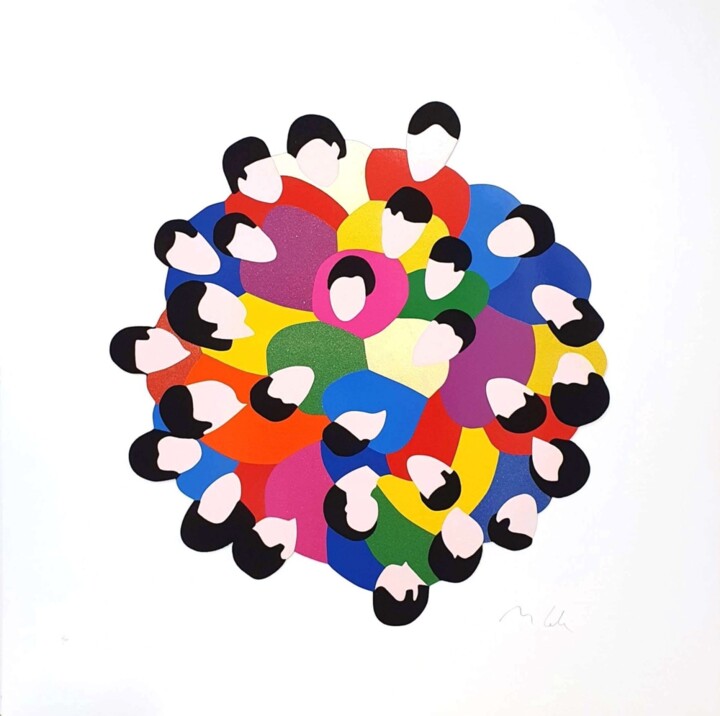 THE BIG HUG. (2024) Printmaking by Marco Lodola
THE BIG HUG. (2024) Printmaking by Marco Lodola
THE BIG HUG (2024) by Marco Lodola
This artifact, titled "THE BIG HUG" and produced in 2024 by Marco Lodola, highlights his expertise in blending vibrant colors and various materials to craft a visually striking creation.
Description and Interpretation: "THE BIG HUG" portrays a vivid, circular cluster of simplified human figures, emphasizing a sense of unity and collective embrace. The overlapping forms and bright, contrasting colors convey a feeling of togetherness and warmth. The lack of detailed facial features allows the viewer to focus on the overall composition and the emotions it evokes, rather than individual identities.
The use of diverse materials such as glitter, metallic leaf, and various textures adds depth and dimension to the piece, making it visually captivating. The combination of these elements with the bold color palette is characteristic of Lodola’s innovative approach to modern art, bridging traditional techniques with contemporary aesthetics.
The circular arrangement of the figures suggests inclusivity and harmony, resonating with themes of community and connection. This creation, like many others by Lodola, manages to capture complex emotions through simple yet powerful visual language. The interplay of colors and materials creates a dynamic and engaging composition that invites viewers to reflect on the beauty of unity and shared human experience.
Marco Lodola: The Painter in the Context of Exhibitions and the Art Market
Lodola’s work has been featured in numerous exhibitions around the world, from Europe to the United States. Some of his notable exhibitions include:
Royal Palace of Caserta (2018) - Lodola exhibited a series of luminous sculptures in the “Tempus-Time” exhibition, curated by Luca Beatrice. This exhibition highlighted his mastery in using light as a medium, transforming traditional sculpture into radiant, captivating pieces.
Blue Note Milan (2018) - Celebrating the 15th anniversary of this iconic jazz club, Lodola’s installations adorned both the façade and the interior, creating a vibrant and immersive experience for visitors.
The Garden of Luminous Dreams (2020) - Held in Piazza Partigiani, Alassio, this exhibition showcased Lodola’s ability to create enchanting environments with his illuminated sculptures, blending art and public spaces seamlessly.
Ariston Theatre, Sanremo (2021) - For the 75th anniversary of the Sanremo Music Festival, Lodola redesigned the façade and created a life-size sculpture tribute to Domenico Modugno, demonstrating his versatility and cultural impact.
Lodola’s unique blend of traditional techniques and modern elements has made his work highly desirable among collectors. His use of neon lights and vibrant colors appeals to a wide audience, from traditional art collectors to fans of contemporary pop culture. The commercial success of his pieces is evident in their presence in prestigious galleries and private collections worldwide.
Beyond traditional art spaces, Lodola’s creations have also made significant inroads into popular culture. He has collaborated with various brands and events, creating installations for fashion shows, music festivals, and public celebrations. These collaborations highlight his ability to transcend the boundaries of conventional art, making his work accessible and engaging to a broader audience.
Lodola’s contributions to the art world have been recognized with numerous awards and accolades. His innovative approach and ability to capture the zeitgeist of modern culture have earned him a place among the most influential contemporary artists of his generation.
Marco Lodola’s impact on the art world is profound and multifaceted. Through his innovative use of light and color, he has redefined the boundaries of modern art, creating works that are both aesthetically captivating and culturally significant. His presence in prestigious exhibitions and the high demand for his pieces in the art market are testaments to his enduring influence and artistic vision. As Lodola continues to push the boundaries of his craft, his legacy in the art world is assured, inspiring future generations of artists and art enthusiasts alike.
Artists Inspired by His Perspective
Marco Lodola's influence on art is unmistakable, especially among creators who utilize light and color as core components of their pieces. Domenico Pellegrino and Stefano Bressani are notable examples, having drawn significant inspiration from Lodola's dynamic and vibrant approach.
Domenico Pellegrino, a Sicilian maestro known for his ironic and dreamlike creations, often explores the intersection of ancient traditions and modernity. His pieces frequently feature superheroes adorned with traditional Sicilian decorations and lights reminiscent of local festive illuminations. This unique blend creates a bridge between the past and present, much like Lodola's fusion of classic forms with neon lights. Pellegrino's exhibitions, such as "Superheroes" and his project "Cosmogonia Mediterranea," have garnered widespread acclaim, illustrating his ability to transform traditional symbols into contemporary art forms that resonate with audiences.
Similarly, Stefano Bressani, renowned for his "Dressed Sculptures," utilizes vibrant colors and intricate fabric designs to create visually stunning and innovative works. His pieces, while seemingly playful, are deeply rooted in sophisticated artistic techniques. Bressani’s approach to combining fabric and steel, as seen in his notable creation "Skultoflower," showcases a blend of traditional craftsmanship with modern artistic vision, echoing Lodola’s innovative use of materials and light. His collaborations and exhibitions, including his tribute to Fortunato Depero and projects like "Picasso ReLOADED," highlight his dedication to evolving his unique artistic language.
Lodola’s impact extends beyond these artists, influencing a broader movement where light and color become central themes in creating modern art that connects with diverse audiences. His pieces not only inspire but also set a benchmark for blending traditional artistic elements with modern technology, thereby continually pushing the boundaries of visual art.
Little-Known Facts about the Artist
Few know that Marco Lodola has collaborated with numerous prestigious companies and brands, creating artistic installations for fashion and design events. Additionally, Lodola is also known for his social commitment: he has created works to support various charitable causes, demonstrating particular sensitivity towards solidarity and support for local communities.
In summary, Marco Lodola is a versatile artist who has reinvented the language of Futurism with a contemporary and vibrant vision. His works, characterized by the masterful use of light and color, continue to enchant and inspire both the public and other artists. His successful exhibitions and recognition in the art market confirm the relevance and lasting impact of his work in the global art scene.


 Selena Mattei
Selena Mattei

